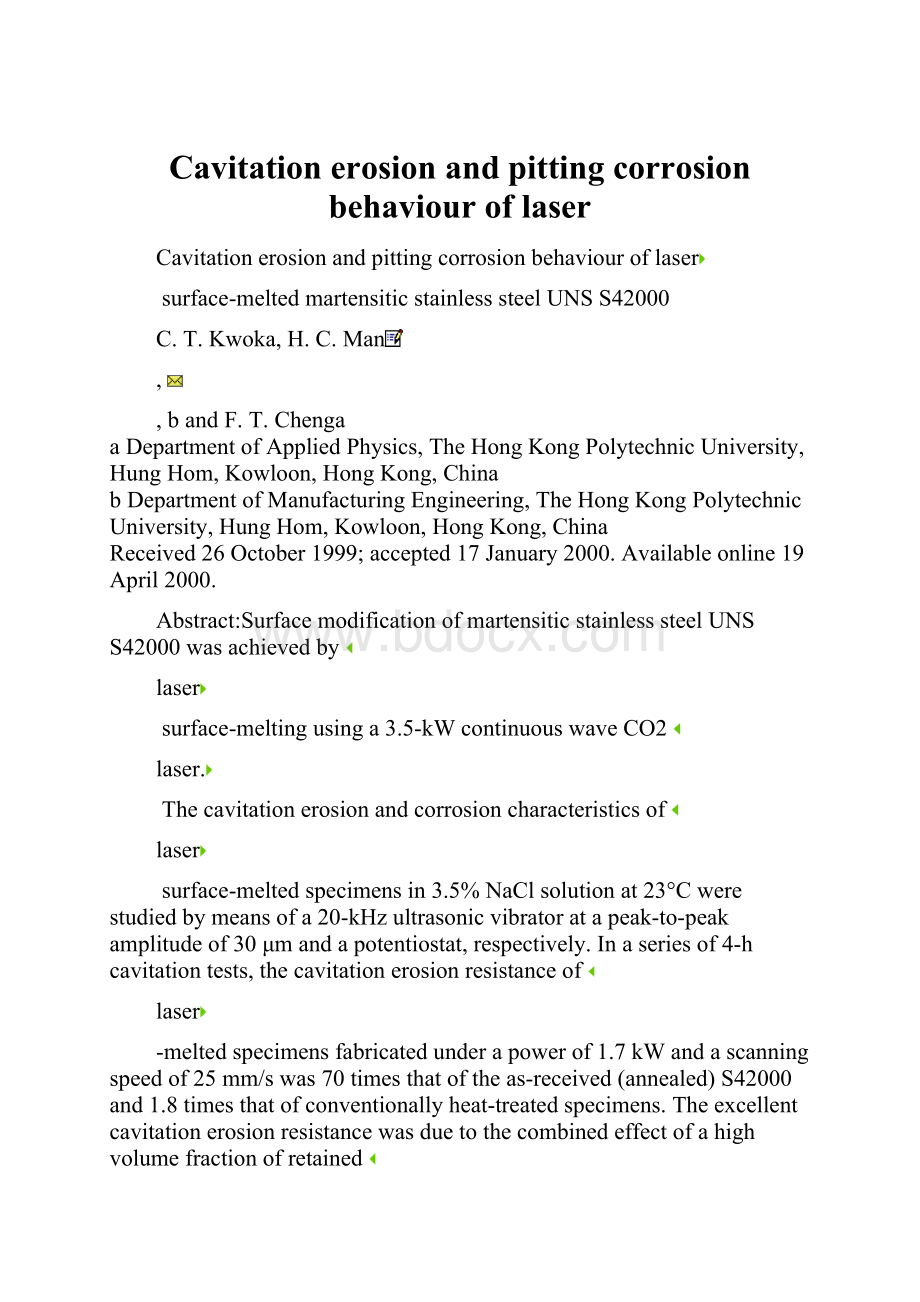Cavitation erosion and pitting corrosion behaviour of laser.docx
《Cavitation erosion and pitting corrosion behaviour of laser.docx》由会员分享,可在线阅读,更多相关《Cavitation erosion and pitting corrosion behaviour of laser.docx(25页珍藏版)》请在冰豆网上搜索。

Cavitationerosionandpittingcorrosionbehaviouroflaser
Cavitationerosionandpittingcorrosionbehaviouroflaser
surface-meltedmartensiticstainlesssteelUNSS42000
C.T.Kwoka,H.C.Man
bandF.T.Chenga
aDepartmentofAppliedPhysics,TheHongKongPolytechnicUniversity,HungHom,Kowloon,HongKong,China
bDepartmentofManufacturingEngineering,TheHongKongPolytechnicUniversity,HungHom,Kowloon,HongKong,China
Received26October1999;accepted17January2000.Availableonline19April2000.
Abstract:
SurfacemodificationofmartensiticstainlesssteelUNSS42000wasachievedby
laser
surface-meltingusinga3.5-kWcontinuouswaveCO2
laser.
Thecavitationerosionandcorrosioncharacteristicsof
laser
surface-meltedspecimensin3.5%NaClsolutionat23°Cwerestudiedbymeansofa20-kHzultrasonicvibratoratapeak-to-peakamplitudeof30μmandapotentiostat,respectively.Inaseriesof4-hcavitationtests,thecavitationerosionresistanceof
laser
-meltedspecimensfabricatedunderapowerof1.7kWandascanningspeedof25mm/swas70timesthatoftheas-received(annealed)S42000and1.8timesthatofconventionallyheat-treatedspecimens.Theexcellentcavitationerosionresistancewasduetothecombinedeffectofahighvolumefractionofretained
austenite
(89%)andamoderatehardness(450Hv).Byusingdifferentprocessingparameters,itwasfoundthatthecavitationerosionresistanceofthe
laser
-meltedspecimensincreasedwiththeincreaseinvolumefractionofretained
austenite,
aresultattributabletothehighmartensitictransformabilityofthe
austenite
inS42000.Ontheotherhand,cavitationerosionresistanceincreasedwiththeincreaseinhardnesstoamaximumvalueandthendroppedwithfurtherincreasesinhardness.Thisindicatedthatmartensitictransformabilityplayedamoreimportantrolethanhardnessincavitationerosion.Thepittingpotentialsofall
laser
-meltedspecimensshiftedinthenobledirection,andthepitsformedinthe
laser
-meltedspecimenswereshallowerascomparedwiththoseformedinas-receivedandhardenedS42000specimens.Theimprovementinpittingcorrosionresistanceresultedfromthedissolutionorrefinementofcarbideparticlesandthepresenceofretained
austenite,
asevidencedbythefactthatthepittingpotentialincreasedlinearlywiththeamountofretained
austenite.
Thepresentstudythusshows,thatwithproperprocessingparameters,boththecavitationerosionandpittingresistancemightbesimultaneouslyimprovedby
laser
-surfacemelting,atleastformartensiticstainlesssteels.
AuthorKeywords:
Laser
surface-melting;Cavitationerosion;Pittingcorrosion;Martensiticstainlesssteel;Retained
austenite
1.Introduction
Cavitationerosionisacommonprobleminengineeringpartsincontactwithaliquidinwhichthelocalpressurefluctuates,andcavitationdamagewillleadtoshorteningofservicelifeormaintenancecycle.Therearenumerousmeansofcombatingcavitationerosion[1and2],andamongthesetechniques,modificationofthecomponentsurfaceisespeciallyeffectiveandattractivesinceitdoesnotaffectthebulkpropertiesofthesubstrate.
Laser
surfacemodification,arelativelynewtechniqueinsurfaceengineering,isparticularlyattractiveasitcanproducesurfacelayerswithmicrostructuresandcompositionsnotattainablebyconventionalmethods.
Laser
surface-melting(LSM)forimprovingthecavitationerosionresistancebymeansofacontinuousNd-YAG
laser
hasbeenattemptedonausteniticstainlesssteelsUNSS31603andUNSS30400,andsuperduplexstainlesssteelUNSS32760inourpreviousstudy[3].Thecavitationerosionresistanceofthe
laser
surface-meltedstainlesssteelswasfoundtobehighlydependentonthemicrostructuralchangeandtheresidualstressinthe
laser
-meltedlayer.OnlythecavitationerosionresistanceofUNSS31603wasimprovedby22%afterLSM.ThelowcarboncontentpresentinthesestainlesssteelslimitstheirhardenabilityandhencelimitsthebeneficialeffectofLSM.
Asfarasstainlesssteelsareconcerned,themartensiticstainlesssteelspossessthehighestcavitationerosionresistancefollowedbyausteniticstainlesssteelswhiletheferriticsteelshavethelowestcavitationerosionresistance[4].Heathcocketal.[4]studiedthecavitationerosionoftwomartensiticstainlesssteelsBS431S29(Fe-15.6%Cr-2.34%Ni-1%Mn-0.8%Si-0.11%C)andDIN4112(Fe-18.5%Cr-1.15%Mo-1%Mn-1%Si-0.91%C),andfoundthatthecavitationerosionresistanceofthehardenedandtemperedmartensiticsteelsincreasedwiththeincreaseinhardness.DIN4112exhibitedahighercavitationerosionresistancethanBS431S29forsimilarheattreatmentconditionsbecauseofthedifferenceinthecarboncontentandtoalesserdegree,thechromiumcontent.Carbonhasbothpositiveandnegativeeffectsoncavitationerosionresistance.ThehighcarboncontentinDIN4112resultedinahigherhardnessinitsmartensiticmatrixontheonehand,andalsoledtotheformationofthecoarsechromiumcarbideswhichprovidedsitesfortheinitiationoferosiondamageontheother.Inaddition,Yebisuyaetal.[5]reportedthatcastmartensiticstainlesssteel(Fe-11–14%Cr-0.5–8%Ni-2–9%Mn-1%Si-0.1%C)hashighcavitationerosionresistanceandissuitableforuseasturbineelementsinwaterplants.Theapplicationofmartensiticstainlesssteelsashigh-speedcomponentsinmarineenvironmentsagainstcavitationdamageisfeasiblebecauseofitshighhardenabilitybysuitableheattreatment.LSMnaturallyoffersaconvenientandeffectivesolutiontosuchaproblemsinceonlythesuperficiallayerismodifiedandthebulkpropertiesofthesubstrateareretained.
Similartoothertypesofsteels,LSMofmartensiticstainlesssteelsleadstothedissolutionoflargecarbides,refinementofthemicrostructure,homogenisationofchemicalcomposition[6],resultinginimprovementofhardness,toughness[7],wearresistance[8],andcorrosionresistance[9]ofthesesteels.Ontheotherhand,unlikeothertypesofstainlesssteels,retainedausteniteisingeneralpresentinthe
laser
-meltedmartensiticstainlesssteels[10,11,12and13].Recently,ColacoandVilar[14]reportedanincreaseoftheproportionofretainedaustenitewithdecreasingpowerdensityandincreasingscanningspeedfor
laser
surface-meltedS42000.Thepresenceandtheamountofretainedausteniteasamicrostructuralcomponenthasaprofoundeffectonthepropertiesandperformanceofmartensiticstainlesssteels.Dependingonthepropertiesconcernedandtheamountpresent,retainedaustenitecanbebeneficialordetrimentaltoanalloy[15].Forexample,retainedausteniteupto10%wasfoundtoincreasethewearresistanceofsteelT10[16],andretainedaustenitecontrolledat20–25%couldincreasetherollingfatiguelifeofbearingsteelsby11.3times[17].TongandZhong[18]investigatedtheeffectofretainedausteniteinhighchromiumcastironsubjecttoimpactabrasivewear,andtheyconcludedthatunderhigh-energyimpact,retainedaustenitewasharmfulwhileunderlow-energyimpact,itwasbeneficial.Theeffectofretainedausteniteinmartensiticstainlesssteelsonthecavitationerosionresistance,however,hasnotbeenreportedintheliterature,norhasstudyontheLSMofmartensiticsteelstoincreasethecavitationerosionresistance.
ThepresentworkaimstoimprovethecavitationerosionresistanceofmartensiticstainlesssteelUNSS42000byLSM,andtoinvestigatetheeffectoftheamountofretainedaustenite.Thecorrosionbehaviourofthe
laser
surface-meltedS42000in3.5%NaClsolutionwillalsobestudied.
2.Experimentalprocedures
2.1.Materialandspecimenpreparation
Theas-receivedS42000,whichhadbeenheat-treatedto780°C,cooledinafurnaceat10°C/hto650°C,andthenair-cooled,wasintheformofaroundbarwithdiameterofhalfaninchandhadahardnessof220Hv.Thenominalchemicalcompositioninwt.%was:
Fe-13.6%Cr-0.5%Mn-0.9%Si-0.38%C-0.3%V.HardeningofS42000wasachievedbyheattreatmentinafurnaceforcomparisonwiththe
laser
-meltedspecimens.SpecimensHT-420-1andHT-420-2werepre-heatedto,andkeptat,850°Cfor45minandthenheat-treatedthroughtheaustenitisingtemperature(1020°C)for15min,followedbyquenchinginliquidnitrogentoroomtemperature.Stressrelieving(tempering)wasdonebykeepingspecimensHT-420-1andHT-420-2at650and250°C,respectively,for150min,followedbyair-cooling.
Theroundbarmaterialwasmachinedtoflat-endstudswithathreadedsectionforattachmenttothevibrationhornforthecavitationtest.Thespecimensforpolarisationstudieswereintheformofadiscof16mmindiameterand3.2mmthickness.ThesurfaceofthespecimensforLSMwassand-blastedinordertoreducethereflectivitytothe
laser
beam.Priortocavitationandpolarisationtests,thesurfaceofallspecimenswasmechanicallypolishedto1μmdiamondfinishinordertokeepthesurfaceroughnessconsistent.Subsequently,thespecimenswerecleaned,degreased,driedandweighedbeforeandaftereachcavitationandpittingcorrosiontest.
2.2.
Laser
surface-melting
LSMwascarriedoutusinga3.5-kWCWCO2laser.ThelaserbeamwasfocusedontothespecimenbyaZnSelenswithfocallengthof170mm.Laser
powerof1100W(156W/mm2)and1700W(240W/mm2)atworkpiecewithabeamsizeof3mmindiameterandbeamscanningspeeds5,15and25mm/swereused.Argonflowingat15l/minwasusedastheshieldinggas.ThedetailsofthelaserparametersforeffectingthemelttracksareshowninTable1.Themeltsurfacewasachievedbyoverlappingofsuccessivemel